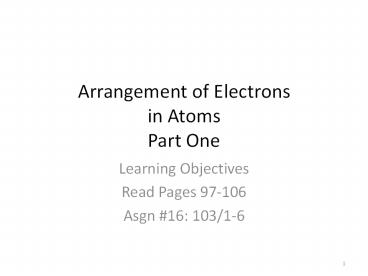Arrangement of Electrons in Atoms Part One - PowerPoint PPT Presentation
1 / 20
Title:
Arrangement of Electrons in Atoms Part One
Description:
Arrangement of Electrons in Atoms Part One ... Explain how the Heisenberg uncertainty principle and the Schrodinger wave equation led to ... ultraviolet, infrared ... – PowerPoint PPT presentation
Number of Views:97
Avg rating:3.0/5.0
Title: Arrangement of Electrons in Atoms Part One
1
Arrangement of Electronsin AtomsPart One
- Learning Objectives
- Read Pages 97-106
- Asgn 16 103/1-6
2
Section 1 Light and Electrons
- Explain the mathematical relationship amount the
speed, wavelength, and frequency of
electromagnetic radiation. - Discuss the dual wave-particle nature of light.
- Discuss the significance of the photoelecvtric
effect and the line-emission spectrum of H to the
development of the atomic model. - Describe the Bohr model of the H atom.
3
Section 2 Quantum Model
- Discuss De Broglies role in the development of
the quantum model of the atom. - Compare and contrast the Bohr model and the
quantum model of the atom. - Explain how the Heisenberg uncertainty principle
and the Schrodinger wave equation led to the idea
of atomic orbitals.
4
- Electromagnetic Radiation (EMR) or light is a
form of energy that moves as a wave through
space. - Electromagnetic Spectrum is made up of many kinds
of EMR visible, X rays, ultraviolet, infrared,
microwaves, and radiowaves.
5
Electromagnetic (E-M) Waves (LIGHT!) Do not
require a medium through which to travel Light
travels at 3.0 x 108 m/s in a vacuum or air Its
wavelength and frequency varies according to the
type of E-M wave
6
Higher frequency ? Greater energy ? More
penetration
- What type has
- Greatest frequency?
- Less frequency than infrared light?
7
c ln
- c , the speed of light which is 3x108 m/s in a
vacuum or air. Units m/s - l, wavelength or distance between corresponding
points on adjacent waves - Units m or nm
- n, frequency or number of waves passing a point
in a given amount of time. Units Hertz, Hz or
1/s or s-1
8
Light Problems What is the frequency of light
whose wavelength is 600 nm?
- nm means 10-9 m
- c ln --gt n c/l
- 3x108 m 5 x 1014 s-1
- 600x10-9 m s
9
Photoelectric Effect
- This is the emission of electrons from a metal
when electromagnetic radiation shines on the
metal.
P. E. shows that energy is emitted in small,
specific packets called quanta. A quantum of
energy is the minimum quantity of energy that can
be lost or gained by an atom.
The photoelectric effect showed that light
behaves as particles, too!
10
E h n
- E, energy of a quantum of radiation in joules, J
- h, Plancks constant is 6.626 x 10-34 Js
- n, frequency in s-1
- Problem What is the frequency of a photon whose
energy is 3.4 x 10-19 J? - n E/h 3.4 x 10-19 J / 6.626 x 10 -34 Js
- n 5.1 x 1014 s-1
- Wavelength-frequency relationship was
proposed by Planck in 1900.
11
- Einstein explained the photoelectric effect was
due to metal absorbing energy in discrete amounts
of photons. - Ground state lowest energy state of an atom
- Excited state state where an atom has a higher
potential energy than ground state.
12
webexhibits.org
13
Tutorvista.com
14
Bohr Model
- 1913 Niels Bohr proposed a hydrogen atom model
where electrons circle the nucleus only in
allowed paths or orbits with a definite amount of
energy. - If an electron absorbs energy, it can go to a
higher level. - If in a higher energy level, an electron can
emit a certain amount of energy to move to a
lower level.
15
-
chemweb.ucc.ie
16
Quantum Model of the Atom
- Questions were unanswered regarding how electrons
could be particles yet they gave off waves of
light. - De Broglie suggested that electrons could be
considered waves confined to space around a
nucleus only at specific frequencies. - Diffraction experiments proved that electron
beams can interfere with each other and produce
areas of low energy and high energy areas as a
result of interference.
17
- Heisenberg Uncertainty Principle (1927) it is
impossible to determine simultaneously both the
position and velocity of an electron or any other
particle. - Schrodinger Wave Equation (1926) - developed an
equation that treated electrons in atoms as
waves. - Heisenberg and Schrodinger laid the foundation
for mathematical descriptions of wave properties
of very small particles such as electrons the
probable location of electrons around the
nucleus. - AKA Quantum Theory and Quantum Numbers.
18
- End of Section 1 and part of Section 2 of Chapter
4 - Arrangement of Electrons in Atoms
19
(No Transcript)
20
(No Transcript)































